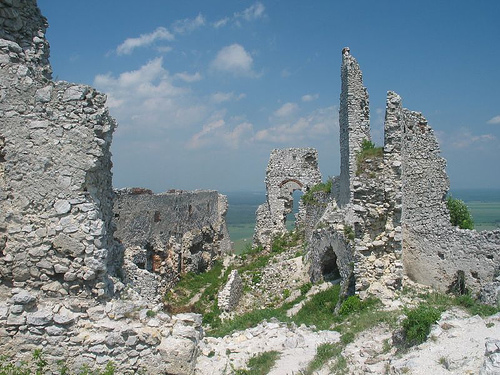

Location: 35 km (22 mi) North of Senec
Constructed: 1256- 73
Plavecký Castle is a medieval citadel situated 35 km (22 mi) North of Senec in Slovakia. Plavecký Castle was constructed in 1256- 73 as a royal fortress to defend the pass below. It was badly damaged by the Imperial forces that stormed Plavecký Castle that was a base for Rakoczi's anti- Habsburg troops. It fell in disrepair and abandoned. You can reach the top of the mountain by taking a trail from village of Plavecke Podhradie. It takes about half an hour to get there.
Like most medieval castles in present-day Slovakia, the Swimming
Castle was built as part of the wave of construction of new castles
after the Mongol invasion of Hungary. From the retrospective document of
Ondrej III. from the year 1291 we learn about the donation of the land
Kitchen Bel IV. Detrich, son of Bratislava mayor Kunt.
He
probably built a castle in this area on the initiative of the king. We
do not know the exact year of its creation, it was probably in the 50s
and 60s of the 13th century. We know that it existed as early as 1273,
when a battle took place under it between the Hungarian army and the
army of Přemysl Otakar II.
Originally, the castle had mainly a
guard function. Due to its location, it was able to control the border
area of the Kingdom of Hungary and the border with the Czech Kingdom.
Thanks to the supervision of Branč Castle and Ostrý Kameň and Korlátka
Castles, which was made possible by the advanced voice, the Swimming
Castle was able to exchange signals with them in the event of danger.
The castle also protected and controlled the path that led to the slopes
of the castle hill. It gradually became an economic and administrative
center
The castle was established as a royal border fortress
between 1256 and 1273. From 1398 it was the property of Stibor of
Stiborice. Until the 16th century, it was owned by the counts of Svätý
Jur and Pezinok, then by the Serédy family, 1553 - 1575 by the Fugger
family, then by the Balašov family. At the time when the castle belonged
to Štefan Balaš, from 1579 to 1584, one of the first book printing
houses in Slovakia operated on the castle. Calendars, bibles, a songbook
and other publications have been published at the Swimming Castle by the
Protestant writer and church dignitary Petr Bornemis.
From 1641
it was continuously owned by the Pálfi family until the 20th century. In
the second half of the 16th century, the castle was rebuilt into a
Renaissance fortress with lower courtyards. It was gradually fortified
again and maintained during the 17th century, when it was supplemented
by new cannon bastions. In 1706 he was damaged by the imperial army,
which conquered him from the rebels. They haven't restored it since. The
seat of the manor passed to Malaciek in the middle of the 17th century.
Conservation work is underway at the castle.
There are also other monuments and attractions around the castle. The Pohanská fortified settlement is located on the same hill. At the northern slope of the hill is the Swimming Cave. At the southern foot of Pohanská Hill are the remains of the perimeter walls of the defunct monastery. There is also a Renaissance manor house in Plavecký podhradí.